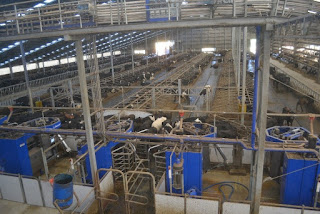Got to sleep-in this beautiful morning in Hamilton! At 8:30AM we hit the
road to our first stop in Morrinsville to get some pastries at the local
bakery. We indulged with some delicious pastries and coffee to start the
morning. In this part of the country, there is a large amount of dairy farms,
so in Morrinsville, there were 42 cow statues throughout the town. While
mingling, we found a farm store to look through to compare the different
products sold in New Zealand to the United States’ products. What a great way
to start the morning!
 |
| One
of the 42 cow statues in Morrinsville. |
Our next stop was Grant Wills’ and Karen Preston’s dairy farm. At this
facility, they milk around 750 cows, two times a day. This farm has sharemilkers.
There are two types of sharemilker facilities: 50-50 and lower order. Lower
order is where there are herd managers that come in and milk the farm owner’s
cows and use their facility. These herd managers also supply the dairy’s
supplies. They split milk checks accordingly. For the 50-50 sharemilkers,
someone owns the farm land and facility and someone else supplies the cattle.
They split the costs and revenue in half. For this farm, we had Chad and Jan
Winke show us their operation, where they are a hybrid of 50-50 and lower order
sharemilker operation. At this facility, they employ two fulltime employees,
plus Chad, and several part time employees, depending on the season.
 |
| The
feed bunks used at Grant Wills’ and Karen Preston’s dairy farm. |
 |
| A
rainy day in New Zealand! |
Chad and Jan Winke own 150 of the cattle on the dairy. They are originally
from Iowa, United States, where they had a 30 cow Guernsey operation with a tie
stall. Jan convinced Chad to move to New Zealand for her job with GEA around
nine years ago. Since then, they have been with four different sharemilking
farms. They have loved their time in New Zealand farming, and enjoy the style
of living.
 |
| Students
listening to Chad and Jan Winke talk about the dairy farm. |
Running a dairy in New Zealand is both similar and different to the U.S..
We were told they had a majority of Fresian-Jersey crossed breeds. At this
dairy, they average 5.5% fat and 4.6% protein in their milk. The milk in New
Zealand is sold on a milk solids basis, and is contracted to Fonterra. The cattle
are kept in one of 102 different pastures and are walked in for milking. The
most the cattle would have to walk in one day is two kilometers to get milked
in a 47 herringbone swing parlor. The cattle are supplemented with several
different feedstuff including: kiwi, palm kernels, distillers’ grains, and fodder
beets. Around 30-35% of their diet is supplemented. The average age of their
cattle are between 5-6 years old, but they have quite a few cows at the age of 14-15
years old.
 |
| Cattle
grazing out in one of the paddocks at the dairy. |
 |
| Some
of the ration for the supplement feed, which included kiwi. |
After many questions were asked and answered, we boarded the bus and
headed to Hobbiton in Matamata. This was the film sight for certain scenes of
the movies: Lord of the Rings and the Hobbit. We learned about the farmers, the
Alexander family, and how their land was chosen for the filming of parts of the
movies. The Alexanders have 1250 hectares of land, with 1250 sheep and some
Angus cattle.
It was a Saturday, which
is rugby day, when the movie scout came to their door to inquire whether he
could look more at their land for the movie. After many tries at knocking, the
Alexanders finally opened the door, and agreed to let him scope out the
property. They instructed the scout to shut every gate, in order to not let out
any sheep, for the Alexanders needed to finish watching the other half of the
rugby game.
 |
| Alana
posing at the dwarf doors found in Hobbiton. |
 |
| Overlooking
the view over Hobbiton. |
We got a lovely tour of the grounds, which started with a filling meal.
The meal consisted of: cooked vegetables, pesto penne, roast beef, roasted
potatoes, basmati rice, and many desserts. Next up was the tour of Hobbiton!
They employ a full staff 365 days a year to keep the grounds looking like
spring to match the set for the movies. We could see every careful detail
thought through by the producers, coming down to every leaf on a tree. Overall,
the whole class enjoyed at least one part of the tour.
 |
| Group
photo over the double arched bridge in Hobbiton. |
Supper was spent in the best buffet
in the country; Skyline Restaurant! This restaurant sits at the top of a large
hill. The students got to try lots of different foods, from roast beef to
sushi. The most exciting part was riding a gondola up to the restaurant. This
was a great way to end a fantastic day!
Bennet & Katelyn G.













GEA Milking Parlor from our company is very flexible and a cow can be milked separately in one box. Visit our website if you want to know more about our milking parlors.
ReplyDelete